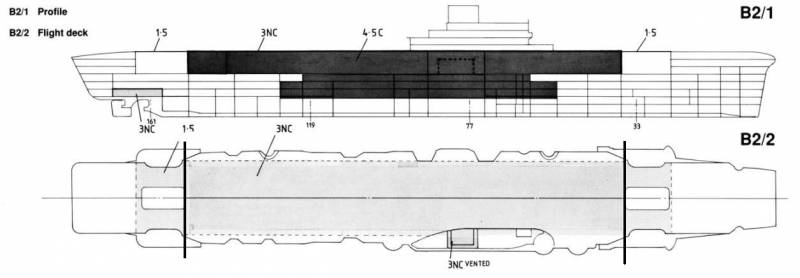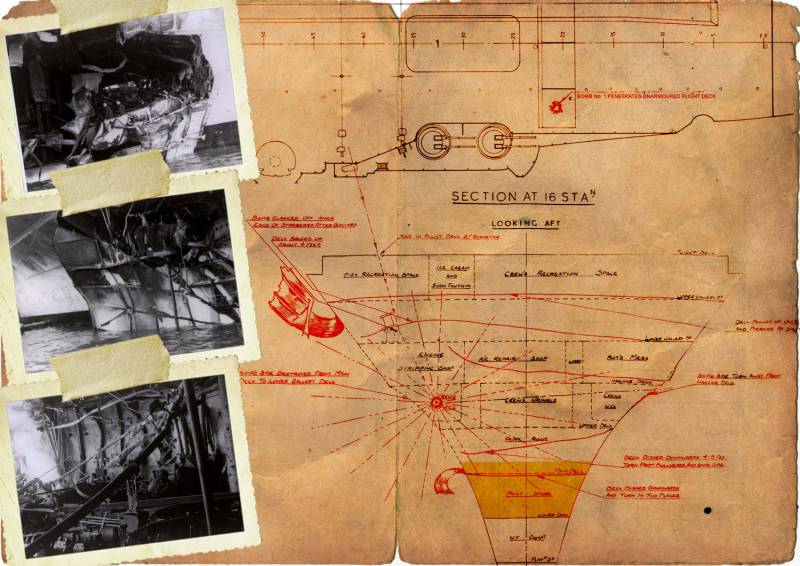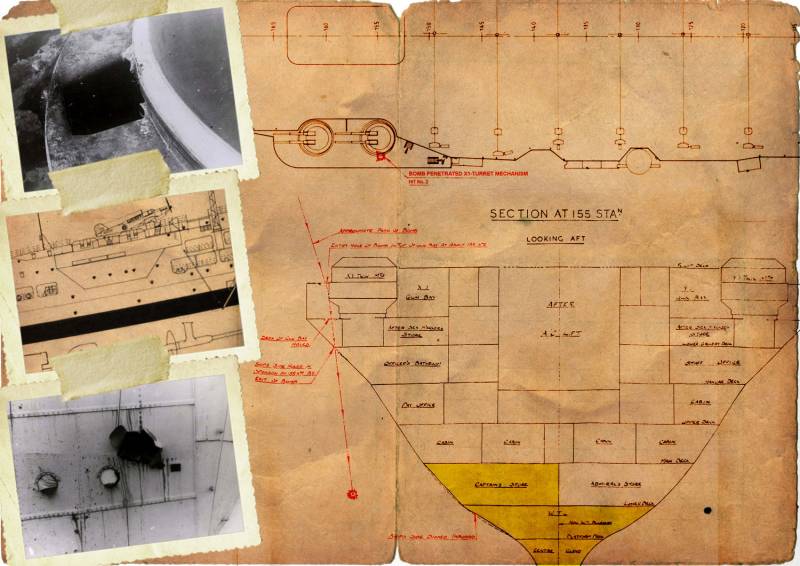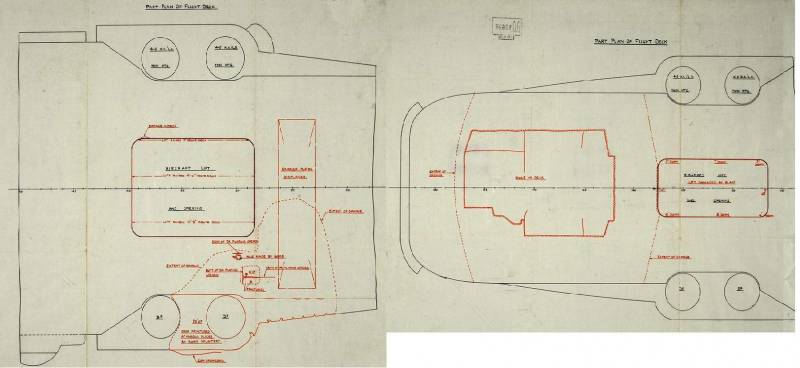British aircraft carriers under the Luftwaffe bombs
Statement of the problem and methodology
British aircraft carriers with an armored flight deck have traditionally received quite high marks from historians. They are considered to be an almost optimal balance of characteristics for operations in confined waters under enemy dominance aviation. And practically no work is complete without praise for the armored flight deck - that distinctive feature that made such operations possible in principle.
The problem is that most of the works do not give any details about the exact place where the bombs fell and about the destruction that they caused. The authors of the book faithfully cite data on six to seven bombs that fell into the Illastries EVC, and another 1-2 in Malta and cheerfully conclude that any other aircraft carrier certainly did not survive such a beating. Readers prefer not to bother with the details, obviously, considering them boring or well-known. The bombs hit, the Germans - the masters, this is the Luftwaffe. The aircraft carriers withstood, the British - well done, it's Royal Royal. This is what the collision refrain looks like.
But what if a curious reader wants more details? Not a brief squeeze such as “a 250-kilogram bomb hit the nose elevator area,” but a full description. What kind of armor was at the point of impact, what kind of destruction did the unfortunate bomb cause? And so on for all the bombs that hit the Illastries and its sisterships. Knowing such information, we can draw conclusions about whether the protection of aircraft carriers was sufficient in thickness and area, and therefore, to give a more reasonable assessment of the project as a whole.
Bad news that for a qualified answer to this question you need to go down a level below and start working with the primary sources. These are reports of commanders and officers of the struggle for survivability, reports of engineers supervising repair and restoration work, etc. This is a dreary business and requires some special training. The good news: some of these primary sources have been processed and made publicly available at armouredcarriers.com. Armed with new knowledge, we can consider the problem of confronting British armor and German bombs in more detail. I would like to emphasize that in the article we will only talk about confronting bombs. The topic of kamikaze confrontation is still waiting for its study.
To begin with, I briefly recall the booking scheme for Victories class aircraft carriers in the amount that is necessary and sufficient to read the article. Our two heroes, “Illastries” and “Formidebl,” had just such a booking scheme. The third, Indomiteable, had thinner walls of the hangars, but this, as we will see later, did not play any role in our cases.
The basis of the basics is an armored box-shaped hangar, the roof of which is the notorious armored flight deck. The thickness of the armor here was 76 mm. The walls of the box are also armored. The main thing we need to do is to note the longitudinal dimensions of the hangar, which define the contour of the deck reservation. These boundaries are two transverse lines, slightly not reaching the bow and stern elevators. Aerial elevators were not included by designers in the protected hangar space. During flight operations, sliding armored doors on the transverse wall of the hangar box opened to the sides, and the plane rolled out onto the lift. Thus, the bomb that fell inside the lines most likely hit the armored deck, you only need to clarify whether it fell into the narrow "corridors" between the hangar and the outer side. If outside the lines, then, accordingly, it is guaranteed not to fall into the space protected by armor. True, the diagram shows protection in the area of elevators (but not the elevators themselves), but it is only 1,5 inches according to the scheme and is exclusively protection from fragments, not bombs. In the future, as we will see, this “defense” made its way even with 250 kg bombs.
Now you can start examining the actual damage received during the combat episodes. Illastries' damage is reported in the Official Damage Report (Bomb & Shell). Damage to the Formidebla is reported by the captain of the ship to the commander of the Mediterranean fleet. Damage to the Indomiteble is given according to the report of the department of the main shipbuilder of the Admiralty about the bomb damage of the ship. Materials posted on the website armouredcarriers.com.
Illastries under the bombs
January 10, 1941 HMS "Illastries" was attacked by two Ju-87 air groups and was seriously damaged.
Hit number 1: 500-kg bomb hit the platform with a pump in the middle of the ship. Having pierced the platform, the bomb struck the hull, reached the armor belt (not to be confused with the armored wall of the hangar) and bounced into the sea without exploding.
Hit number 2: 500 kg bomb. To the bow, the very edge of the flight deck, devoid of armor. The overhang of the deck was broken, and the bomb (half-armor-piercing according to the assumptions of the report compilers) exploded in the air three meters above the waterline, disfiguring the nose with fragments.
Hit # 3: 250 kg caliber bomb. On the starboard side, almost exactly in the pom-pom near the island superstructure. The explosion distorted the installation, but the deck in the area of the explosion survived. The photo shows that the sheets just parted a little. It is important to note two points. First: the report indicates that the deck here was reinforced, but not armored. Second: pom-pom played the role of a buffer that took a hit on itself. The bomb in the report is allegedly classified as having a fuse with a contact detonation or simply fragmentation.
Hits No. 4, 5, 7: one 250-kg bomb and two 250-kg or 500-kg bombs fell almost exactly in the aft elevator. Explosions brought him down, turning him into a pile of scrap metal. All four feed installations of 4,5-inch guns were de-energized. The metal fire screen, which additionally protected the entrance to the hangar, was destroyed and thrown into the hangar space.
Hit number 6. We pass to the most interesting.
The heavy armor-piercing bomb landed precisely on the armored flight deck. In terms of mass, estimates vary widely. Initially, the report had 500 kg, which were then manually adjusted to 1000. American engineers in Norfolk, where the Illastries underwent repairs, also tended to the number 1000. But at the same time, those authors who consider the operation from the point of view of the Germans clearly indicate that their planes carried bombs of up to 500 kg. Personally, I also tend to an easier option - simply by the amount of evidence
The impact of the bomb was terrifying. She pierced the armor of the flight deck and exploded about half a meter above the hangar deck in the center of sector C. Although the report indicates that the armor was pierced with difficulty (the bomb had only just managed to defeat the armor plate), this was hardly a comfort to the British. Noteworthy details follow: the heavy tail section was thrown up and burst through the armor deck again (!). The blast wave went through all sections of the hangar A, B, C right up to the nose lift, sweeping away the metal fire screens and destroying the aircraft. The fragments mowed down the people, including the crew members responsible for the fire extinguishing system. But here the English are incredibly lucky. In sector C, where the bomb hit and the fire extinguishing system did not work, there were only 4 Fulmar fighters and there were no bombs or torpedoes. In sector B there were only 2 Swordfish, but 6 torpedoes. And then the fire extinguishing system was put into action. In sector A there were 7 Swordfish with deep and semi-armor-piercing bombs. There were no fires, but the system was activated just in case. A very important factor that worked in favor of the British was that the “Illastries” carried only half of the full-time air group.
Thus, on January 10, the Illastries received seven direct hits, although six are usually indicated. Apparently, hit No. 1 is excluded, since the bomb hit the edge of the deck and did not explode. Of these, only four were “full-fledged”: No. 4, 5, 6, 7 (five, if you add No. 3, although there the pom-pom served as a buffer).
The ship received another direct hit on January 16 in Malta. Hit # 8: a 500 kg caliber bomb hit the unarmored aft of the flight deck and exploded in the captain’s cabin.
So, only one of the 8 bombs fell exactly on the armored flight deck and caused its penetration, which casts doubt on the familiar version of its huge role in saving the ship. But for now, let's not rush and consider the remaining examples.
Formidedle and Indomiteble under the bombs
On May 26, 1941, after the attack of the Scarpanto airfield during the battle for Crete, Formidebl received two bombs.
No. 1: a 1000-kg semi-armor-piercing bomb landed in a new part in front of the elevator and exploded. The bomb went about 10 meters deep and broke through 4 decks: flight, upper and lower gallery and hangar. The aerial lift was severely bent and incapacitated, and the destruction as a whole was very extensive.
No. 2: a 1000-kg semi-armor-piercing bomb hit the stern, just like the sponson of 4,5-inch guns on the starboard side, pierced it and exploded under water. From the explosion, sheathing broke, causing a slight penetration of water.
Damage was not critical, but the speed dropped to 18-20 knots. Although nothing particularly dangerous happened, it was in the interests of the ship and its crew to return to the port as soon as possible, since any unrest threatened more extensive flooding. Note that there were no direct hits on the armored deck.
On August 12, 1942, Indomiteble received two bombs during Operation Pedestal.
A bomb of No. 1 caliber 250 kg fell to the right of the nasal elevator, causing noticeable damage and a medium-intensity fire. The elevator was disabled.
A bomb of No. 2 caliber 250 kg fell behind the feed elevator and exploded inside the ship. The hole in the deck was simply huge, but the aft elevator could continue to work, albeit at a slower speed. Torpedoes were stored in one of the rooms in the area of the explosion, which, however, did not detonate. The document does not say why.
One of the close gaps caused water to flow. Assessing the damage, the British refused to further participate in the operation of the ship. Here again, we note that both hits were in the unarmored part of the deck.
Conclusions
Starting to get acquainted with the topic, I first of all planned to figure out how effectively the 76-mm armored deck held German bombs. The reality was shocking: the advertised armored deck did not participate in the protection of British aircraft carriers from bombs in any way! They simply didn’t fall into it, but when they did, they struck. The ill-fated Illastries was saved not by the flight deck armor, it just didn’t pass the test, but by a small number of aircraft, the absence of bombs and torpedoes in hangar sector C and the fire system that worked in sector B. Of the 12 hits, only one hit the famous armored the deck. This seems to violate all logic, but, nevertheless, this zone, which accounted for 62% of the flight deck area, was tested for strength only once. Another moment is equally unexpected: nine hits were at the extremities, which totaled only about a third of the ship’s area.
In all cases, damage led to the loss of combat capability of the ship. Of course, the damage would always be sufficient to disable any other aircraft carrier. Our heroes also were no exception and did not show anything extraordinary. In addition, we note that the armored longitudinal walls of the hangars played no role. But the transverse armored walls in many cases could be useful (isolation of the gentle filling of the hangars from numerous hits in the extremities). Due to the only case of a fire extinguishing system in the hangar, it was not possible to at least superficially assess its quality, which in the sources varies from “good” to “excellent”.
Conclusion
Despite the unambiguity of my conclusions, I am far from considering the topic of the real effectiveness of the armored flight deck closed. My immersion in the topic was too shallow. The second point is that the twelve hits considered are not statistically significant, to say that their distribution, mainly in the extremities, is logical. What if the British were just unlucky (or, conversely, unlucky, because the effectiveness of deck armor was still in question) and in fact getting into the central region as a whole happened more often? The answer to this question can only be the use of statistics on the distribution of bombing hits in other aircraft carriers of the WWII period. In conclusion, I note that against the kamikaze, the "British" looked much more convincing.
The author wants to thank the team www.armouredcarriers.com for the kind permission to use the site materials in the article and a huge contribution to the promotion of stories.
Sources of
1 Ross Watton The aircraft carrier Victorious.
2. Website armouredcarriers.com.






Information